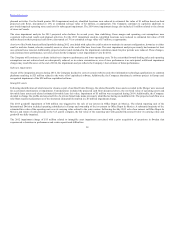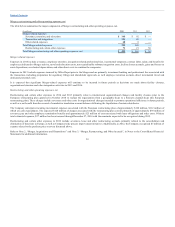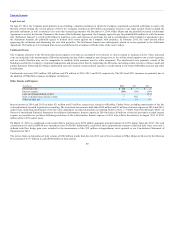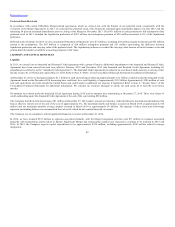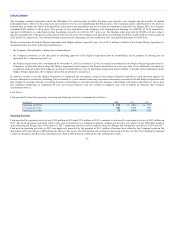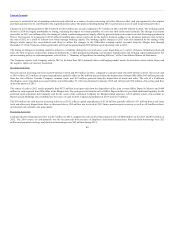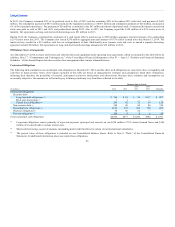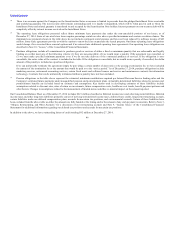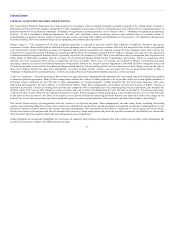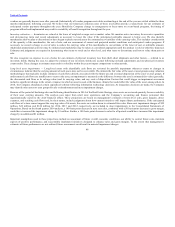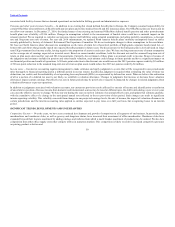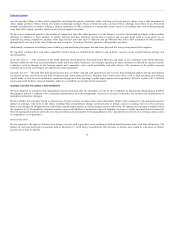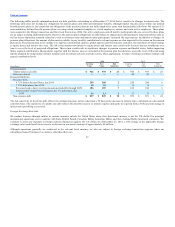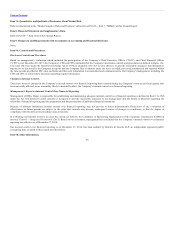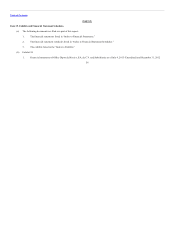OfficeMax 2014 Annual Report Download - page 50
Download and view the complete annual report
Please find page 50 of the 2014 OfficeMax annual report below. You can navigate through the pages in the report by either clicking on the pages listed below, or by using the keyword search tool below to find specific information within the annual report.
Table of Contents
vendors are generally known soon after year-end. Substantially all vendor program receivables outstanding at the end of the year are settled within the three
months immediately following year-end. We believe that our historical collection rates of these receivables provide a sound basis for our estimates of
anticipated vendor payments throughout the year. Should the Company change its arrangements to focus more on event-based programs, the timing of
programs offered and implemented may result in variability of benefit recognition throughout the year.
Inventory valuation — Inventories are valued at the lower of weighted average cost or market value. We monitor active inventory for excessive quantities
and slow-moving items and record adjustments as necessary to lower the value if the anticipated realizable amount is below cost. We also identify
merchandise that we plan to discontinue or have begun to phase out and assess the estimated recoverability of the carrying value. This includes consideration
of the quantity of the merchandise, the rate of sale, and our assessment of current and projected market conditions and anticipated vendor programs. If
necessary, we record a charge to cost of sales to reduce the carrying value of this merchandise to our estimate of the lower of cost or realizable amount.
Additional promotional activities may be initiated and markdowns may be taken as considered appropriate until the product is sold or otherwise disposed.
Estimates and judgments are required in determining what items to stock and at what level, and what items to discontinue and how to value them prior to
sale.
We also recognize an expense in cost of sales for our estimate of physical inventory loss from theft, short shipments and other factors — referred to as
inventory shrink. During the year, we adjust the estimate of our inventory shrink rate accrual following on-hand adjustments and our physical inventory
count results. These changes in estimates may result in volatility within the year or impact comparisons to other periods.
Long-lived asset impairments — Long-lived assets with identifiable cash flows are reviewed for possible impairment whenever events or changes in
circumstances indicate that the carrying amount of such assets may not be recoverable. We estimate the fair value of the asset or asset groups using valuation
methodologies that typically include estimates of cash flows directly associated with the future use and eventual disposition of the asset or asset groups. If
undiscounted cash flows are insufficient to recover the asset, an impairment is measured as the difference between the asset’s estimated fair value (generally,
the discounted cash flows or its salvage value) and its carrying value, and any costs of disposition. Factors that could trigger an impairment assessment
include a significant change in the extent or manner in which an asset is used or the business climate that could affect the value of the asset, among others. In
2014, the Company abandoned certain capitalized software following information technology decisions. As integration decisions are made, the Company
may identify other assets or asset groups for sale or abandonment and incur impairment charges.
Because of the period of declining sales and following identification in 2014 of the Real Estate Strategy, store assets are reviewed quarterly for recoverability
of their asset carrying amounts. The analysis uses input from retail store operations and the Company’s accounting and finance personnel that
organizationally report to the chief financial officer. These projections are based on management’s estimates of store-level sales, gross margins, direct
expenses, and resulting cash flows and, by their nature, include judgments about how current initiatives will impact future performance. If the anticipated
cash flows of a store cannot support the carrying value of its assets, the assets are written down to estimated fair value. Store asset impairment charges of $25
million, $26 million and $124 million for 2014, 2013 and 2012, respectively, are included in Asset impairments in the Consolidated Statements of
Operations. Based on the fourth quarter 2014 analysis, a 100 basis point decrease in next year sales, combined with a 50 basis point decrease in gross margin,
would have increased the impairment charge by $1 million. Further, a 100 basis point decrease in sales for all periods would have increased the impairment
charge by an additional $1 million.
Important assumptions used in these projections include an assessment of future overall economic conditions, our ability to control future costs, maintain
aspects of positive performance, and successfully implement initiatives designed to enhance sales and gross margins. To the extent that management’s
estimates of future performance are not realized, future assessments could result in material impairment charges.
48


